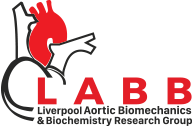Research
LABB Group Research
Research Area
We work on a number of projects related to the structure, mechanical properties and biochemistry of aortic tissues. We are interested in understanding the mechanisms leading to thoracic aortic aneurysms, aortic dissection and age-related arterial stiffening. Our current key projects are summarised here.
Nanomechanical Properties of Aortic Tissue
A main thrust of our research currently involves understanding rare aortic diseases such as Acute Type A aortic dissection (AAD). AAD involves a splitting in the aortic wall which is life-threatening and often occurs in young patients without any previous relevant medical history. We are using a range of novel techniques to try and better understand the risk of aortic dissection developing. We conduct this research with vascular surgeons at Liverpool Heart and Chest Hospital and also collaborators in a range of other disciplines such as biochemistry and mathematical modelling. Our funding for this research comes from a number of sources including British Heart Foundation.
Aortic Medial Amyloid
The most common form of localised amyloid occurs in the aortic media (aortic medial amyloid; AMA) and is estimated to occur in 97% of Caucasian people above the age of 50. Despite this prevalence the pathological impact of AMA is unknown, but it is thought to contribute to age-related diminished elasticity of the vessels and may underlie the pathogenesis of sporadic thoracic aortic aneurysm. The main constituent of AMA is a 50 amino acid polypeptide medin. For the past several years we have been investigating the structure of medin, the mechanisms that trigger medin aggregation and the cellular pathways affected by its presence. Currently we are investigating the potential role of medin in aortic aneurysm and dissection using patient tissue. Our project is funded by the British Heart Foundation.
Arterial Stiffening
Arteries become stiffer with the natural ageing process and this stiffening which is associated with cardiovascular disease is exacerbated with conditions such as diabetes. For many years, we have focussed on understanding how the structure and mechanical properties of large arteries is compromised at the microscopic and sub-microscopic level. Arteries are multi-layered anatomical structures with a complicated organisation of cells of cellular and extracellular matrix components within these layers. Hence, understanding how they change with ageing and disease processes is not trivial.



